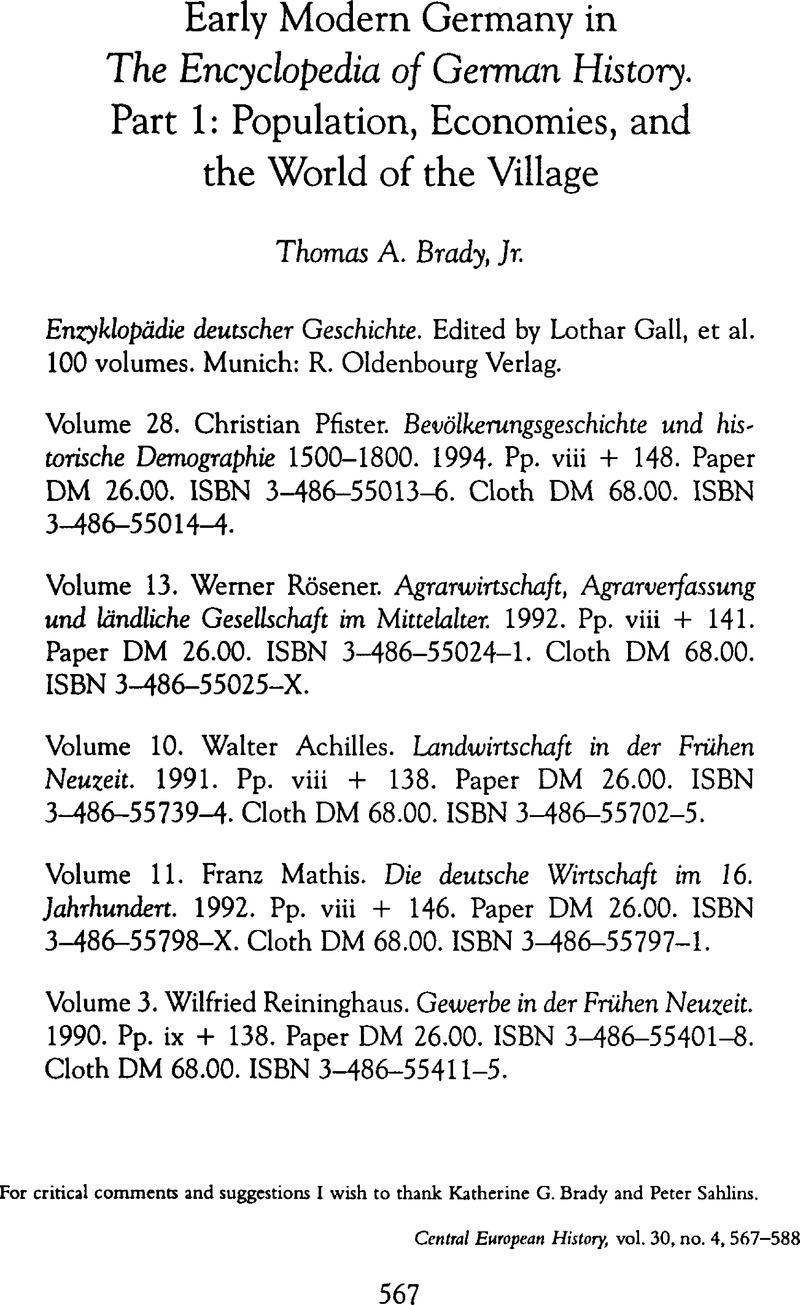Published online by Cambridge University Press: 16 December 2008

For critical comments and suggestions I wish to thank Katherine G. Brady and Peter Sahlins.
1. Moraw, Peter, Von offener Verfassung zu gestalteter Verdichtung: Das Reich im späten Mittelalter, 1250 bis 1490 (Berlin, 1985).Google Scholar
2. They are: Leuschner, Joachim, ed., Deutsche Geschichte, 10 vols. (Gottingen, 1973–1984);Google ScholarGroh, Dieter, ed., Prolyläen Geschichte Deutschlands, 8 vols. (Berlin, 1983–);Google ScholarDeutsche Geschichte, 12 vols. (Siedler, Berlin, 1982–1994);Google ScholarWehler, Hans-Ulrich, ed., Moderne Deutsche Geschichte, 12 vols. (Frankfurt am Main, 1985–1996);Google Scholar and Moraw, Peter, ed., Die Neue Deutsche Geschichte, 12 vols. (Munich. 1984–).Google Scholar
3. Quoted by Strauss, Gerald, Sixteenth-Century Germany: Its Topography and Topographers (Madison, 1959), 40.Google Scholar See Sheehan, James J., “What Is German History? Reflections on the Role of the Nation in German History and Historiography,” Journal of Modern History 53 (1981): 1–23.CrossRefGoogle Scholar
4. Mathis, 3. Reininghaus, 6, adopts the German boundaries of 1871.
5. The situation is described by Vries, Jan de, “Population,” in Handbook of European History, 1400–1600: Late Middle Ages, Renaissance, and Reformation, ed. Brady, Thomas A. Jr, Oberman, Heiko A., and Tracy, James D., 2 vols. (Leiden, 1994–1995), 1:1–50.Google Scholar
6. Which are assigned to a volume on Population in the Middle Ages. authored by Neithardt Bulst.
7. Pfister, 9–10.
8. Ibid., 11–13.
9. Ibid., 14–15.
10. Ibid., 80.
11. Vries, Jan de and Woude, Ad van der, The First Modern Economy: Success, Failure, and Perseverance of the Dutch Economy, 1500–1815 (Cambridge, 1997).CrossRefGoogle Scholar
12. Most prominent among whom are Arthur E. Imhof, J. Knodel, Ronald W. Lee, J. Houdaille, and Lutz Berkner.
13. Abel, Wilhlem, Geschichte der deutschen Landwirtschaft vom frühen Mittelalter bis zum 19. Jahrhundert, 3rd ed. (1978 [1962]);Google ScholarLütge, Friedrich, Geschichte der deutschen Agrarverfassung vom frühen Mittelalter bis zum 19. Jahrhundert, 2nd ed. (1967 [1963);Google ScholarFranz, Günther. Geschichte des deutschen Bauernstandes vom frühen Mittelalter bis zum 19. Jahrhundert, 2nd ed. (1976 [1970]). They are respectively vols. II–IV of the Deutsche Agrargeschichte (Stuttgart: Eugen Ulmer Verlag).Google Scholar
14. Rösener, 95–102.
15. Bois, Guy, Crise du féodalisme: économie rurale et démographie en Normandie orientale du début du 14e siècle au milieu du 16e siècle, Cahiers de la Fondation nationals des sciences politiques, no. 202 (Paris: Presses de la Fondation nationals des sciences politiques, 1976);Google Scholar in English as The Crisis of Feudalism: Economy and Society in Eastern Normandy, c. 1300–1550, Past and Present Publications (Cambridge, 1984).Google Scholar
16. Rösener, 110–15.
17. Achilles, 2–4.
18. Ibid., 32–33.
19. Ibid., 45–50.
20. Ibid., 69–75.
21. Ibid., 81–88.
22. Ibid., 92–94.
23. Mathis, 22.
24. Ibid., 27–30.
25. Ibid., 40–41.
26. Ibid., 51, criticizing Winfried Schulze.
27. Ibid., 53–57.
28. Ibid., 100–6.
29. Reininghaus, 5.
30. Ibid., 49.
31. Ibid., 91.
32. Ibid., 98.
33. Holenstein, 1.
34. And supplemented for Austria by A. Hoffmann. Holenstein, 30–34.
35. See, e.g., Trossbach's effective criticism of Herman Rebel's reductionist treatment of “housed” and “unhoused” peasants, in Holenstein, 73.
36. Critiques developed by Heide Wunder and Jan Peters respectively. Holenstein, 76–78
37. In Hagen's, William W.searching critique of Hans Rosenberg's argument, Central European History, 24, No. 1 (1991): 24–50.Google Scholar Holenstein, 89–91.
38. Holenstein, xi.
39. Trossbach, 1–5.
40. Ibid., 230–21.
41. Ibid., 31.
42. Ibid., 4950.
43. Ibid., 54–55.
44. Ibid., 55.
45. Ibid., 64. The Göttingen group includes Hans Medick, Peter Kriedte, Jürgen Schlumbohm, and Alf Lüdtke.
46. Among the most noteworthy are Rudolf Braun on the Zürcher Oberland, Arno Fitz on Vorarlberg, Josef Mooser on the County of Ravensberg, and David W. Sabean on Neckarhausen, Hans Medick on Laichingen, and Jürgen Schlumbohm on Osnabrück.
47. Trossbach, 77.
48. For orientation from a broader perspective, see Wiesner, Merry E., “Family, Household, and Community,” in Handbook of European History, 1400–1600, 1:51–78.Google Scholar
49. Trossbach, 89.
50. Ibid., 94–95.
51. Edited respectively by Scribner, Bob and Ogilvie, Sheilah (London, 1996–1997).Google Scholar